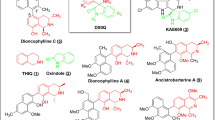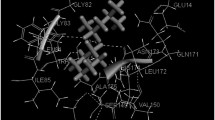Abstract
A new hybrid compound 5 containing a ruthenocene, a 4-aminoquinoline, and a 1,2,4-trioxane within a single molecular structure has been synthesized and evaluated for antimalarial potential. In order to ascertain the role of each component of hybrid 5, its antimalarial activity has been measured against chloroquine-resistant and chloroquine-sensitive strains of Plasmodium falciparum in comparison with those of chloroquine, artemisinin, a ruthenocene-trioxane compound 9 not containing an aminoquinoline, the precursor trioxane ketone 4, and a trioxane dimer 10. Hybrid 5 displays high antimalarial activity, in the mid to low nanomolar IC50 range, and low cytotoxicity toward healthy mammalian cells, which translates into good selectivity indexes. The potency of 5 is consistently higher than those of chloroquine, the parent metal-free trioxane, and compound 9, the structural intermediate featuring a ruthenocene moiety bound to the trioxane but lacking the aminoquinoline. These results validate our hypothesis that it is the combination of the aminoquinoline, the ruthenocenyl moiety, and the trioxane in a single molecule that provides the enhanced antiplasmodial activity, and highlight the concept of hybrid compounds as a strategy that deserves further attention.
Graphical Abstract








Similar content being viewed by others
References
Alessio E (2011) Bioinorganic medicinal Chemistry. Wiley-VCH, Weinheim
Andrae D, Haeussermann U, Dolg M, Stoll H, Preuss H (1990) Energy-adjusted ab initio pseudopotentials for the second and third row transition elements. Theor Chim Acta 77:123–141
Anthony MP, Burrows JN, Duparc S, Moehrle JJ, Wells TN (2012) The global pipeline of new medicines for the control and elimination of malaria. Malar J 11:316
Ariey F et al. (2014) A molecular marker of artemisinin-resistant Plasmodium falciparum malaria. Nature 505:50–55
Baramee A, Coppin A, Mortuaire M, Pelinski L, Tomavo S, Brocard J (2006) Synthesis and in vitro activities of ferrocenic aminohydroxynaphthoquinones against Toxoplasma gondii and Plasmodium falciparum. Bioorg Med Chem 14:1294–1302
Beagley P, Blackie MAL, Chibale K, Clarkson C, Meijboom R, Moss JR, Smith PJ (2002) Synthesis and antiplasmodial activity in vitro of new ruthenocene–chloroquine analogues. J Chem Soc, Dalton Trans 23:4426–4433
Beagley P, Blackie MAL, Chibale K, Clarkson C, Meijboom R, Moss JR, Smith PJ, Su H (2003) Synthesis and antiplasmodial activity in vitro of new ferrocene–chloroquine analogues. Dalton Trans 15:3046–3051
Blackie MAL, Beagley P, Croft SL, Kendrick H, Moss JR, Chibale K (2007) Metallocene-based antimalarials: an exploration into the influence of the ferrocenyl moiety on in vitro antimalarial activity in chloroquine-sensitive and chloroquine-resistant strains of Plasmodium falciparum. Bioorg Med Chem 15:6510–6516
Becke AD (1993) Density-functional thermochemistry III. The role of exact change. J Chem Phys 98:5648–5652
Bellot F, Cosledan F, Vendier L, Brocard J, Meunier B, Robert A (2010) Trioxaquines as new hybrid antimalarial drugs. J Med Chem 53:4103–4109
Bergamo A, Gaiddon C, Schellens JHM, Beijnen JH, Sava G (2012) Approaching tumour therapy beyond platinum drugs: status of the art and perspectives of ruthenium drug candidates. J Inorg Biochem 106:90–99
Bergamo A, Sava G (2011) Ruthenium anticancer compounds: myths and realities of the emerging metal-based drugs. Dalton Trans 40:7817–7823
Biamonte MA, Wanner J, Le Roch KG (2013) Recent advances in malaria drug discovery. Bioorg Med Chem Lett 23:2829–2843
Biot C, Castro W, Botte CY, Navarro M (2012) The therapeutic potential of metal-based antimalarial agents: implications for the mechanism of action. Dalton Trans 41:6335–6349
Biot C, Nosten F, Fraisse L, Ter-Minassian D, Khalife J, Dive D (2011) The antimalarial ferroquine: from bench to clinic. Parasite 18:207–214
Bosman A, Mendis KN (2007) A major transition in malaria treatment: the adoption and deployment of artemisinin-based combination therapies. Am J Trop Med Hyg 77:193–197
Briolant S, Parola P, Fusai T, Madamet-Torrentino M, Baret E, Mosnier J, Delmont JP, Parzy D, Minodier P, Rogier C, Pradines B (2007) Influence of oxygen on asexual blood cycle and susceptibility of Plasmodium falciparum to chloroquine: requirement of a standardized in vitro assay. Malar J 6:44
Charman SA et al. (2011) Synthetic ozonide drug candidate OZ439 offers new hope for a single-dose cure of uncomplicated malaria. Proc Natl Acad Sci USA 108:4400–4405
Chibale K, Moss JR, Blackie M, van Schalkwyk D, Smith PJ (2000) New amine and urea analogs of ferrochloroquine: synthesis, antimalarial activity in vitro and electrochemical studies. Tetrahedron Lett 41:6231–6235
Conyers RC, Mazzone JR, Tripathi AK, Sullivan DJ, Posner GH (2015) Antimalarial chemotherapy: orally curative artemisinin-derived trioxane dimer esters. Bioorg Med Chem Lett 25:245–248
Cosledan F, Fraisse L, Pellet A, Guillou F, Mordmuller B, Kremsner PG, Moreno A, Mazier D, Maffrand JP, Meunier B (2008) Selection of a trioxaquine as an antimalarial drug candidate. Proc Natl Acad Sci USA 105:17579–17584
Cossi M, Rega N, Scalmani G, Barone V (2003) Energy, structures, and electronic properties of molecules in solution with the C-PCM solvation model. J Comput Chem 24:669–681
Daher W, Pelinski L, Klieber S, Sadoun F, Meunier V, Bourrie M, Biot C, Guillou F, Fabre G, Brocard J, Fraisse L, Maffrand JP, Khalife J, Dive D (2006) In vitro metabolism of ferroquine (SSR97193) in animal and human hepatic models and antimalarial activity of major metabolites on Plasmodium falciparum. Drug Metab Dispos 34:667–682
Dechy-Cabaret O, Benoit-Vical F, Loup C, Robert A, Gornitzka H, Bonhoure A, Vial H, Magnaval JF, Seguela JP, Meunier B (2004) Synthesis and antimalarial activity of trioxaquine derivatives. Chemistry 10:1625–1636
Delhaes L, Biot C, Berry L, Delcourt P, Maciejewski LA, Camus D, Brocard JS, Dive D (2002) Synthesis of ferroquine enantiomers: first investigation of effects of metallocenic chirality upon antimalarial activity and cytotoxicity. Chem Bio Chem 3:418–423
Desjardins RE, Canfield CJ, Haynes JD, Chulay JD (1979) Quantitative assessment of antimalarial activity in vitro by a semiautomated microdilution technique. Antimicrob Agents Chemother 16:710–718
Ditchfield R, Hehre WJ, Pople JA (1971) Self-consistent molecular-orbital methods. IX. An extended gaussian-type basis for molecular-orbital studies of organic molecules. J Chem Phys 54:724–728
Dubar F, Egan TJ, Pradines B, Kuter D, Ncokazi KK, Forge D, Paul JF, Pierrot C, Kalamou H, Khalife J, Buisine E, Rogier C, Vezin H, Forfar I, Slomianny C, Trivelli X, Kapishnikov S, Leiserowitz L, Dive D, Biot C (2011) The antimalarial ferroquine: role of the metal and intramolecular hydrogen bond in activity and resistance. ACS Chem Biol 6:275–287
Dubar F, Khalife J, Brocard J, Dive D (2008) Ferroquine, an ingenious antimalarial drug: thoughts on the mechanism of action. Molecules 13:2900–2907
Fisher LC, Blackie MA (2014) Tetraoxanes as antimalarials: harnessing the endoperoxide. Mini Rev Med Chem 14:123–135
Frisch MJ et al. (2010) Gaussian, Inc., Wallingford, CT
Hartinger CG, Zorbas-Seifried S, Jakupec MA, Kynast B, Zorbas H, Keppler BK (2006) From bench to bedside--preclinical and early clinical development of the anticancer agent indazolium trans-[tetrachlorobis(1H-indazole)ruthenate(III)] (KP1019 or FFC14A). J Inorg Biochem 100:891–904
Jensen M, Mehlhorn H (2009) Seventy years of Resochin in the fight against malaria. Parasitol Res 105:609–627
Lambros C, Vanderberg JP (1979) Synchronization of Plasmodium falciparum erythrocytic stages in culture. J Parasitol 65:418–420
Lee C, Yang W, Parr RG (1998) Development of the Colle-Salvetti correlation-energy formula into a functional of the electron density. Phys Rev B 37:785–789
Li Q, Weina PJ (2013) Antimalarial drugs: the age of the artemisinins. Nova Science Publishers. New York
Marfurt J, Chalfein F, Prayoga P, Wabiser F, Kenangalem E, Piera KA, MacHunter B, Tjitra E, Anstey NM, Price RN (2011) Ex vivo drug susceptibility of ferroquine against chloroquine-resistant isolates of Plasmodium falciparum and P. vivax. Antimicrob Agents Chemother 55:4461–4464
Miotto O et al. (2013) Multiple populations of artemisinin-resistant Plasmodium falciparum in Cambodia. Nat Genet 45:648–655
National Institutes of Health (2010). Dose ranging study of ferroquine with artesunate in African adulst and children with uncomplicated Plasmodium falcuparum malaria. https://clinicaltrials.gov/ct2/show/NCT00988507. Accessed 11 July 2016
Navarro M, Vasquez F, Sánchez-Delgado RA, Pérez H, Sinou V, Schrevel J (2004) Toward a novel metal-based chemotherapy against tropical diseases. 7. Synthesis and in vitro antimalarial activity of new gold-chloroquine complexes. J Med Chem 47:5204–5209
Noffke AL, Habtemarian A, Pizarro AM, Sadler PJ (2012) Designing organometallic compounds for catalysis and therapy. Chem Commun 48:5219–5246
Opsenica I, Opsenica D, Lanteri CA, Anova L, Milhous WK, Smith KS, Solaja BA (2008) New chimeric antimalarials with 4-aminoquinoline moiety linked to a tetraoxane skeleton. J Med Chem 51:6216–6219
Rademaker-Lakhai JM, van der Bongard D, Pluim D, Beijnen JH, Schlens JMH (2004) A phase I and pharmacological study with Imidazolium-trans-DMOS-imidazole-tetrachlororuthenate, a novel ruthenium anticancer agent. Clin Cancer Res 10:3717–3727
Rajapakse CS, Martínez A, Naoulou B, Jarzecki AA, Suárez L, Deregnaucourt C, Sinou V, Schrével J, Musi E, Ambrosini G, Schwartz GK, Sánchez-Delgado RA (2009) Synthesis, characterization, and in vitro antimalarial and antitumor activity of new ruthenium(II) complexes of chloroquine. Inorg Chem 48:1122–1131
Sanders R, Mueller-Westerhoff UT (1996) The lithiation of ferrocene and ruthenocene: a retraction and an improvement. J Organomet Chem 512:219–224
Trager W, Jensen JB (1976) Human malaria parasites in continous culture. Science 193:673–675
Wells TN, Hooft van Huijsduijnen R, Van Voorhis WC (2015) Malaria medicines: a glass half full? Nat Rev Drug Discov 14:424–442
WHO World malaria report 2015. http://www.who.int/malaria/publications/world-malaria-report-2015/report/en/. Accessed 11 July 2016
Acknowledgements
Work performed at Brooklyn College was funded by the NIH-NIGMS through Grant # SC1GM089558 to R.A.S-D. Work at the laboratory of Paris was performed thanks to UMR 7245 MNHN/CNRS funding. Work at the laboratory of Marseille was funded by the UMR-MD3 - Infections Parasitaires: Transmission, Physiopathologie et Thérapeutique.
Author information
Authors and Affiliations
Corresponding author
Ethics declarations
Conflict of interest
The authors declare that they have no competing interests.
Additional information
This article was written in memory of Roberto A. Sánchez-Delgado.
Electronic supplementary material
Rights and permissions
About this article
Cite this article
Martínez, A., Deregnaucourt, C., Sinou, V. et al. Synthesis of an organo-ruthenium aminoquinoline-trioxane hybrid and evaluation of its activity against Plasmodium falciparum and its toxicity toward normal mammalian cells. Med Chem Res 26, 473–483 (2017). https://doi.org/10.1007/s00044-016-1769-6
Received:
Accepted:
Published:
Issue Date:
DOI: https://doi.org/10.1007/s00044-016-1769-6




